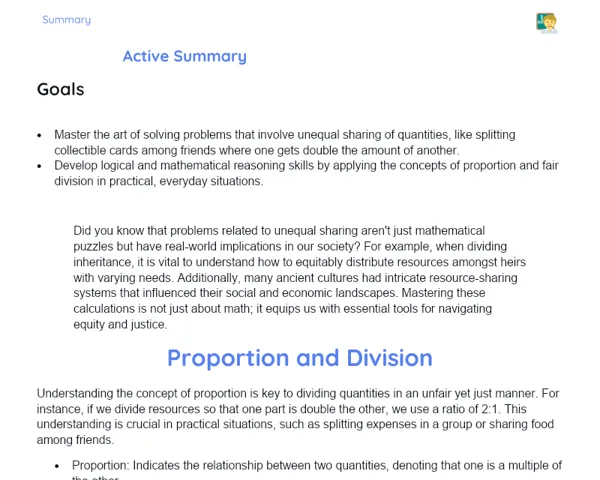Socioemotional Summary Conclusion
Goals
1. Grasp the significance and practical applications of exponential equations in solving mathematical problems.
2. Showcase your ability to solve exponential equations using real-life examples and hands-on exercises.
Contextualization
Have you ever noticed how exponential equations subtly influence our daily lives? Whether it’s tracking population changes in our cities, computing compound interest at banks, or even modelling the spread of diseases, these equations offer an insightful look into many real-world scenarios. Let’s explore this fascinating area of mathematics and see how it reshapes our understanding of everyday phenomena. Ready to embark on this journey? Let’s begin! 🚀🔢
Exercising Your Knowledge
Definition of Exponential Equation
An exponential equation is one in which the variable is in the exponent. Such equations form the backbone of many models that describe rapid growth or decay in natural and social sciences, as well as in our daily lives.
-
An exponential equation is generally expressed as a^x = b, where 'a' is the base and 'x' is the exponent.
-
We often use these equations to describe fast-changing scenarios, like city population growth or the decay of radioactive substances.
-
Solving these equations usually involves rewriting the bases so that the exponents can be compared directly.
Properties of Exponents
A clear understanding of exponent properties is key to manipulating and solving exponential equations efficiently. These properties serve as reliable tools to simplify complex expressions.
-
Multiplication of Exponents: a^m * a^n = a^(m+n). This is especially useful when you need to combine terms with the same base.
-
Division of Exponents: a^m / a^n = a^(m-n). Handy for simplifying equations where terms with identical bases are divided.
-
Power of a Power: (a^m)^n = a^(m*n). This rule aids in solving equations involving multiple layers of exponentiation.
-
Conversion of Roots to Fractional Exponents: √a = a^(1/2). This converts radicals into exponential form, making them easier to work with.
Base Transformation
Changing the base of an exponential equation can simplify the process of finding the unknown exponent. This strategy often transforms a complex equation into a much more manageable one.
-
For example, to solve 2^x = 4, we can write 4 as 2^2. This gives us 2^x = 2^2, leading directly to x = 2.
-
Such base transformations simplify the equation, making it easier to compare the exponents and solve the problem.
-
Understanding how to rewrite numbers, like representing 27 as 3^3, is crucial when handling more challenging exponential equations.
Key Terms
-
Exponential Equation: An equation in which the variable is found in the exponent.
-
Base: The number that is raised to a power in an exponential expression.
-
Exponent: The number that indicates how many times the base is multiplied by itself.
-
Logarithm: The inverse function of exponentiation, useful in solving more complicated exponential equations.
-
Power: The result obtained when a base is raised to a given exponent.
For Reflection
-
How did you feel while working through exponential equations? What were your main emotions and how did you handle them?
-
Can you think of a real-life scenario that might be explained by an exponential equation? How might understanding these equations help in tackling or interpreting that situation?
-
During problem-solving, if you worked in a team, how did that experience affect both your emotions and your learning? What insights did you gain about teamwork and communication?
Important Conclusions
-
Exponential equations are robust tools for modelling growth and decay in many fields, including biology, chemistry, economics, and physics.
-
A solid grasp of exponent properties and base transformations is essential for simplifying and solving these equations.
-
Beyond enhancing mathematical proficiency, mastering exponential equations fosters a better understanding of real-world phenomena such as population dynamics and financial growth.
-
Reflecting on and managing your emotions during problem-solving enhances overall resilience and contributes positively to the learning process.
Impacts on Society
Exponential equations play a transformative role in our modern society. In financial sectors, these equations are fundamental in calculating compound interest, which helps individuals and businesses forecast their finances accurately. Similarly, during health crises like pandemics, exponential models assist authorities in predicting the spread of diseases and in formulating relevant policies. Moreover, when students relate these mathematical concepts to issues like urban growth or environmental conservation (such as monitoring endangered species), it inspires them to apply their skills meaningfully in real life.
Dealing with Emotions
To manage your emotions while tackling exponential equations, consider practising the RULER method. After each study session, take a few moments to acknowledge the emotions you experienced—be it frustration or satisfaction. Reflect on what triggered these feelings and how they influenced your approach to the task. Writing your thoughts in a journal can be very beneficial. Finally, plan ahead by incorporating strategies like regular breaks, deep-breathing exercises, or seeking help when needed, to better navigate future challenges.
Study Tips
-
Regularly revise the properties of exponents and logarithms to keep these concepts fresh in your mind.
-
Make it a habit to solve different types of exponential equations weekly, using resources from textbooks and online platforms.
-
Consider forming a study group with your peers; collaborative sessions can lead to a better understanding of difficult problems and offer mutual support.



